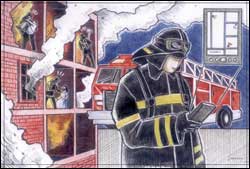’Smart’ buildings to guide future first responders

"Intelligent" building systems may someday allow firefighters and other first responders to better respond to emergencies by providing information such as building floor plans and real-time data from motion, heat, biochemical and other sensors and video cameras.
The best response to a building emergency is a fast and informed one. The National Institute of Standards and Technology (NIST) is working with the building industry as well as the public safety and information technology communities to achieve both objectives.
NIST researchers are studying how “intelligent” building systems can be used by firefighters, police and other first responders to accurately assess emergency conditions in real-time. One of the biggest problems faced by first responders is a lack of accurate information. Where is the fire within the building? How big is it? Are there flammable chemicals stored nearby?
NIST is working with industry to develop standards to allow manufacturers to create intelligent building systems that use various types of communication networks (including wireless networks) to assist first responders in assessing and mitigating emergencies. The systems would send information such as building floor plans and data from motion, heat, biochemical and other sensors and video cameras directly to fire and police dispatchers who then can communicate detailed information about the scene to first responders.
NIST recently released video presentations that demonstrate how an “Intelligent Building Response” program would work. The videos outline team efforts to create a system of interoperable data content and communications standards that would link first responders with “intelligent” building systems. Firefighters are shown using laptops to track the spread of a developing fire on a floor plan even before reaching the scene. Other real-time building sensor information includes status information concerning a specific building’s mechanical systems, elevators, lighting, security system and fire systems, the locations of building occupants, and temperature and smoke conditions.
Media Contact
All latest news from the category: Architecture and Construction
Newest articles

Bringing bio-inspired robots to life
Nebraska researcher Eric Markvicka gets NSF CAREER Award to pursue manufacture of novel materials for soft robotics and stretchable electronics. Engineers are increasingly eager to develop robots that mimic the…

Bella moths use poison to attract mates
Scientists are closer to finding out how. Pyrrolizidine alkaloids are as bitter and toxic as they are hard to pronounce. They’re produced by several different types of plants and are…

AI tool creates ‘synthetic’ images of cells
…for enhanced microscopy analysis. Observing individual cells through microscopes can reveal a range of important cell biological phenomena that frequently play a role in human diseases, but the process of…





















